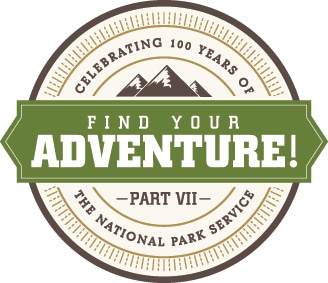Southern Utah’s Zion National Park may not be heaven, but you can see it from there
Life is too short to spend your days sitting back and watching the world go by. Especially when you consider the wide variety of adventures to be had in the 400-plus units under the protection of the National Park Service (NPS). As the NPS celebrates its 100th birthday this  summer, we’ll be right here beside you as we continue our yearlong series full of unforgettable experiences – from mild to wild – that are unique to America’s national parks. Places where we sincerely hope you’ll Find Your Adventure.
summer, we’ll be right here beside you as we continue our yearlong series full of unforgettable experiences – from mild to wild – that are unique to America’s national parks. Places where we sincerely hope you’ll Find Your Adventure.
It’s been said that there is no heaven on earth, but there are pieces of it. Like Zion National Park.
If that sounds like hyperbole, bear in mind this park’s very name implies a heavenly refuge. And while you’re unlikely to find any pearly gates or harp-strumming cherubim, there are definitely places where this 229-square-mile reserve does feel divinely inspired.
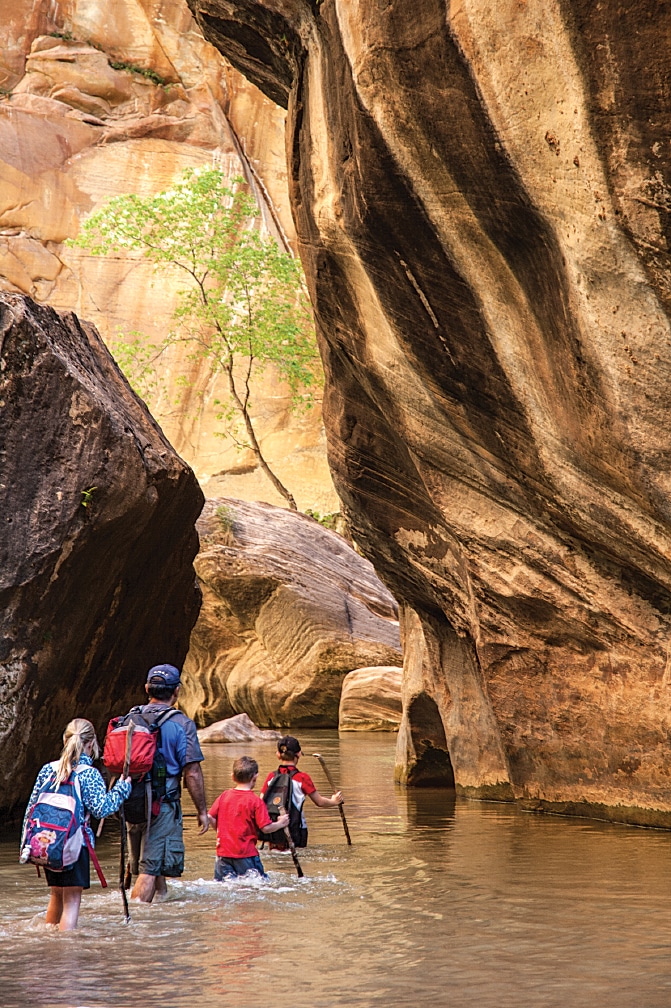
A hike through The Narrows – aptly named, as it’s the narrowest section of Zion Canyon – requires walking through the Virgin River.
Earthly Paradise
Located in southwestern Utah, Zion National Park lies at the intersection of three significant geographic regions: the Colorado Plateau, the Great Basin and the Mojave Desert. That makes it a crossroads for the wide variety of plant and animal life that call these distinct and diverse environments home.
The Zion landscape is also as rugged as they come, full of narrow slot canyons, massive buttes, 2,000-foot cliffs, rushing rivers and soaring natural arches. The red-and-tan-colored Navajo sandstone here makes for a vibrant backdrop, with shades of purple, orange, red and green emerging as the sun makes its way across the impossibly blue high-desert sky.
Human habitation of this area began roughly 10,000 years ago. From the year 500 to around 1300 (when they disappeared), the Anasazi and Parowan Fremont people lived here. Mormon settlers, who gave this place its heavenly name, came along in the 1860s. In 1909, the area was named a national monument and it became Utah’s first national park 10 years later.
Solitude or Scenery
As with any expedition, it helps to get to know the lay of the land before starting out. In the case of Zion, that means understanding there are two main parts to the park, each of which has its distinct advantages.
The northwestern corner of Zion National Park, known as Kolob Canyons, is conveniently located at Exit 40 off Interstate 15. This 5-mile scenic drive is typically less crowded than the main section of the park and therefore is a good place for those seeking solitude.
The main part of the park is accessed from the south entrance in Springdale, Utah, via state Route 9, which leads to I-15 and the town of St. George. Though it’s bound to be more crowded, it is also home to Zion’s most spectacular scenery and should definitely not be missed.
This main section of the park can also be accessed via the east entrance, which leads you through the 1.1-mile-long Zion-Mount Carmel Tunnel and along a series of steep switchbacks. Be aware that motorhomes taller than 11 feet 3 inches and wider than 7 feet 9 inches will need a $15 tunnel permit, and can only travel this section of roadway during limited hours. The oversize permit fee covers the cost of rangers who temporarily suspend two-way traffic through the tunnel long enough for an RV to pass through. Vehicles taller than 13 feet 1 inch are prohibited.

The Angels Landing trail is rated as strenuous and there’s a steep, narrow ridge to the summit where panoramic views await intrepid hikers.
Walk On
As far as how to best see Zion National Park, the most time-honored method – putting one foot in front of the other – is still the best.
As for where to stretch those legs, the park has nearly two dozen hiking trails. These range from short, easy strolls along paved paths to challenging all-day hikes with large elevation gains and steep drop-offs.
If you’re looking for something less strenuous, try the 2.2-mile round-trip paved trail known as Riverside Walk, which follows the Virgin River along the bottom of the canyon. The paved 1.2-mile round-trip Lower Emerald Pool Trail is another good choice that leads to a picturesque waterfall.
On the opposite end of the spectrum, the 5.4-mile round-trip hike to the appropriately named Angels Landing is as famous for its stunning views as it is for its difficulty. Hardcore hikers may also want to try hoofing it 14 miles round-trip to the Kolob Arch, one of the largest freestanding natural arches in the U.S.
Finally, the subject of hiking in Zion National Park wouldn’t be complete without a mention of The Narrows. This classic 8.4-mile round-trip hike will have you walking in the rocky bed of the Virgin River itself, which can be a great – if somewhat slippery – way to cool off on a hot summer’s day. And don’t worry if you’re not up for the whole hike – doing just the first mile-long section at the end of Riverside Walk will lead you to the most spectacular and narrowest part of the river’s deeply incised gorge.
Going Up
If stretching your legs in the horizontal plane isn’t exciting enough, we suggest you look to the valley’s rock walls to plan a vertical escape.
With all the rock faces in this part of the country, it should come as no surprise that Zion National Park is at the epicenter of the sport of rock climbing. Area guides and climbing schools offer everything from half-day sessions to give you a taste of the sport to multiday programs designed to teach you advanced moves used in big wall climbs. All of which can be adapted to your interest and ability levels with safety being the No. 1 priority.
On a related note, Zion is an ideal place to explore the sport of canyoneering. If you’ve never heard of canyoneering, you can think of it as a combination of hiking and rock climbing with some occasional swimming thrown in as you make your way through remote red-rock slot canyons. While it’s not for the faint of heart, with the help of experienced guides and instructors, the wide variety of available classes and tours will take you places few people ever get to go and help you do things that you never thought possible.
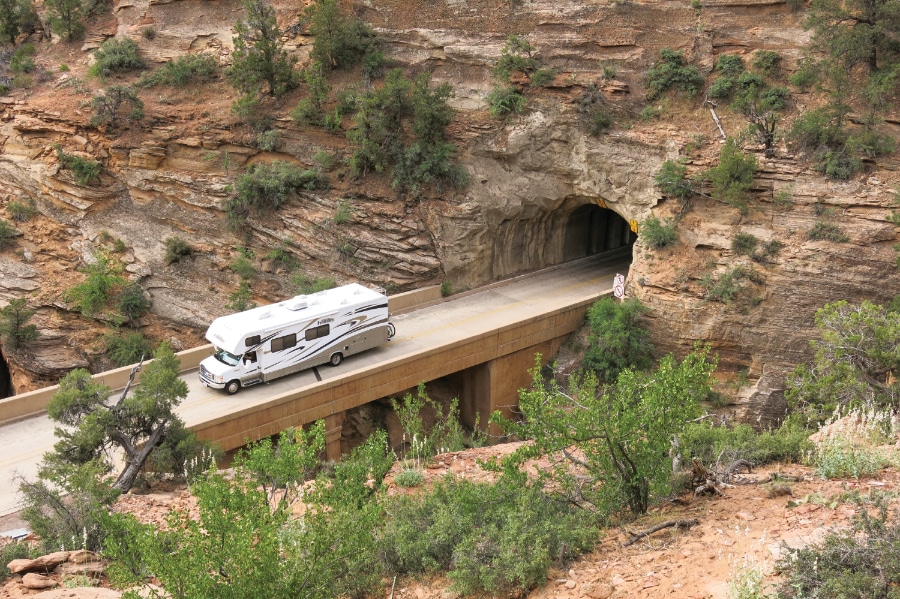
Motorhomes taller than 11 feet 3 inches and wider than 7 feet 9 inches will need a $15 permit to travel through the Zion-Mount Carmel Highway tunnel, and can only drive this section of roadway during limited hours. Vehicles taller than 13 feet 1 inch are not permitted in the tunnel.
Horsing Around
For folks who believe four legs are better than two, you’ll find Zion National Park is a prime spot for horseback riding. Several local outfitters offer traditional trail rides through this beautiful red-rock country lasting from one hour to a half day. Chuck wagon dinners and overnight horseback tours are also offered.
Serious horse lovers will gravitate to the more in-depth program at Jacob’s Ranch (435-635-1552, www.ziontrailrides.com) where their daylong intensive promises to teach you the secret language of horses. From there, you’ll move on to an increasingly advanced rider training that will have you ready to gallop by the time you hit the trail.
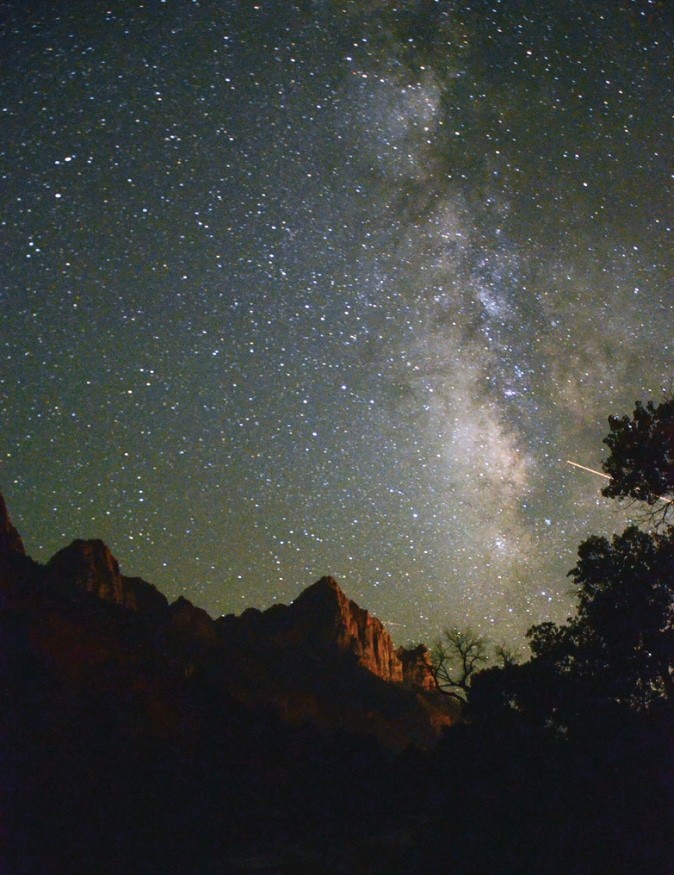
On a clear night, head outside and look up at the stars to see views that rival the famous Zion daytime scenery.
In the Dark
For all the natural beauty on display here, the one sight most visitors miss is the night sky.
Zion National Park’s clear air and lack of light pollution combine to give visitors views of a starscape that’s guaranteed to be far more vivid than what they can see at home. For a guided tour of the night sky, be sure to check at the visitor center to see if rangers will be offering any formal astronomy programs during your time here.
If not, well, don’t let that stop you. Head out after dark and find a place removed from artificial light sources. Give your eyes at least 15 minutes to adjust to the darkness, then simply lay back and enjoy the celestial light show.
Stellar Views
Ultimately reveling in the stars above you may be as close as you actually get to heaven. But look carefully and you’ll find pieces of it wherever you turn in Zion National Park.
Getting Around
From spring through fall, free shuttle buses provide access to the locations in the main part of the park. Shuttles run from early morning to late evening, as often as every seven minutes at peak times. A separate free shuttle service provides transportation within the town of Springdale.
Even with the free shuttles, traffic can be bad at the park entrances so plan on arriving early to avoid the crowds. Alternately, you can park in Springdale and take the town shuttle to the Zion visitor center.
Because of the shuttle system, be sure to bring everything you’ll need to spend the day in the park with you, including water/snacks, walking shoes, sunscreen, a hat and sunglasses.
The scenic Zion-Mount Carmel Tunnel can accommodate larger RVs only with permits and at special times. Check with rangers at the visitor center to find out more.
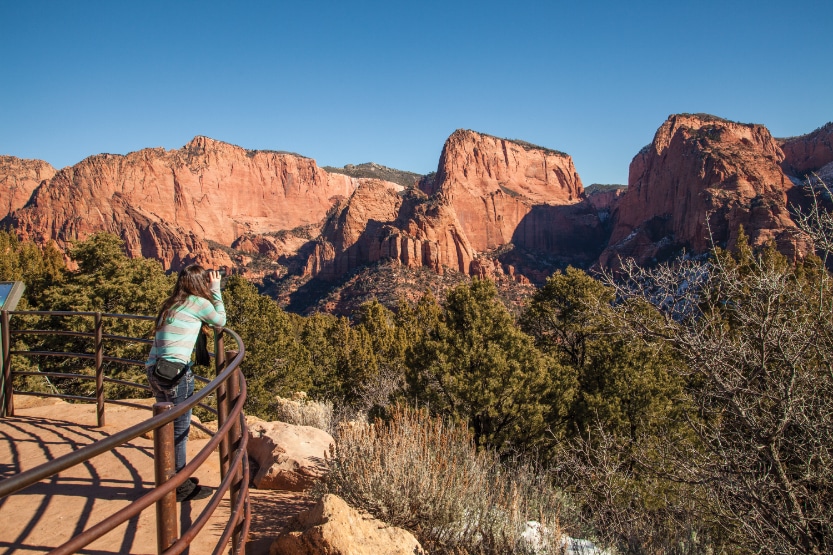
Kolob Canyons Viewpoint is located in the northern, quieter section of the park and can be accessed via a 5-mile scenic drive along Kolob Canyons Road.
Camping
Zion’s South Campground features 117 sites with no hookups, available on a first-come, first-served basis. A dump station and potable water are on-site. Sites are often claimed by midmorning so get an early start if you hope to snag one.
The park’s Watchman Campground offers 95 RV sites with electric service, and accepts reservations (877-444-6777, www.recreation.gov).
Many commercial RV parks can be found nearby, including Zion Canyon Campground and RV Resort (435-772-3237, www.zioncamp.com); Zion River Resort (888-822-8594, www.zionriverresort.com); Zion RV & Campground (877-290-5756, www.zionrv.com); and Zion West RV Park (435-627-9004, http://zionwestrv.com).

